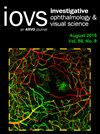iPSC 衍生的 LCHADD 视网膜色素上皮细胞易受脂质过氧化影响,转染野生型 AAV-HADHA 载体后可恢复正常。
IF 5
2区 医学
Q1 OPHTHALMOLOGY
引用次数: 0
摘要
目的 长链 3-羟基乙酰-CoA脱氢酶缺乏症(LCHADD)是一种脂肪酸氧化紊乱,由线粒体三功能蛋白(TFP)α亚基 HADHA 中常见的 c.1528G>C 致病变体引起。我们从 LCHADD 患者培养的皮肤成纤维细胞中建立了诱导多能干细胞(iPSC)衍生的 RPE 细胞模型并对其进行了表征,同时测试了添加野生型(WT)HAHDA 是否能挽救 LCHADD-RPE 中发现的表型。方法我们构建了一种rAAV表达载体,其中含有3' 3xFLAG标记的人HADHA cDNA,受巨细胞病毒(CMV)增强子-鸡β肌动蛋白(CAG)启动子(CAG-HADHA-3XFLAG)的转录控制。结果LCHADD-RPE表达TFP亚基,积累3-羟基肉碱,不能氧化棕榈酸酯,释放的酮体比WT-RPE少。当 LCHADD-RPE 暴露于二十二碳六烯酸(DHA)时,它们的氧化应激增加、脂质过氧化、活力下降,而抗氧化剂可挽救它们,这可能解释了 LCHADD 中 RPE 损失的病理机制。与对照组相比,表达 TFPα WT 拷贝的转导 LCHADD-RPE 将 TFPα-FLAG 结合到线粒体中的 TFP 复合物中,积累的 3-羟基肉碱显著减少,对棕榈酸酯的反应释放出更多酮体,暴露于 DHA 后对氧化应激的抵抗力更强。结论iPSC衍生的LCHADD-RPE易受脂质过氧化介导的细胞死亡影响,并能被rAAV递送的外源HADHA挽救。这些结果为 AAV-HADHA 基因添加疗法治疗 LCHADD 患者的脉络膜视网膜病变带来了希望。本文章由计算机程序翻译,如有差异,请以英文原文为准。
iPSC-Derived LCHADD Retinal Pigment Epithelial Cells Are Susceptible to Lipid Peroxidation and Rescued by Transfection of a Wildtype AAV-HADHA Vector.
Purpose
Progressive choroid and retinal pigment epithelial (RPE) degeneration causing vision loss is a unique characteristic of long-chain 3-hydroxyacyl-CoA dehydrogenase deficiency (LCHADD), a fatty acid oxidation disorder caused by a common c.1528G>C pathogenic variant in HADHA, the α subunit of the mitochondrial trifunctional protein (TFP). We established and characterized an induced pluripotent stem cell (iPSC)-derived RPE cell model from cultured skin fibroblasts of patients with LCHADD and tested whether addition of wildtype (WT) HAHDA could rescue the phenotypes identified in LCHADD-RPE.
Methods
We constructed an rAAV expression vector containing 3' 3xFLAG-tagged human HADHA cDNA under the transcriptional control of the cytomegalovirus (CMV) enhancer-chicken beta actin (CAG) promoter (CAG-HADHA-3XFLAG). LCHADD-RPE were cultured, matured, and transduced with either AAV-GFP (control) or AAV-HADHA-3XFLAG.
Results
LCHADD-RPE express TFP subunits and accumulate 3-hydroxy-acylcarnitines, cannot oxidize palmitate, and release fewer ketones than WT-RPE. When LCHADD-RPE are exposed to docosahexaenoic acid (DHA), they have increased oxidative stress, lipid peroxidation, decreased viability, and are rescued by antioxidant agents potentially explaining the pathologic mechanism of RPE loss in LCHADD. Transduced LCHADD-RPE expressing a WT copy of TFPα incorporated TFPα-FLAG into the TFP complex in the mitochondria and accumulated significantly less 3-hydroxy-acylcarnitines, released more ketones in response to palmitate, and were more resistant to oxidative stress following DHA exposure than control.
Conclusions
iPSC-derived LCHADD-RPE are susceptible to lipid peroxidation mediated cell death and are rescued by exogenous HADHA delivered with rAAV. These results are promising for AAV-HADHA gene addition therapy as a possible treatment for chorioretinopathy in patients with LCHADD.
求助全文
通过发布文献求助,成功后即可免费获取论文全文。
去求助
来源期刊
CiteScore
6.90
自引率
4.50%
发文量
339
审稿时长
1 months
期刊介绍:
Investigative Ophthalmology & Visual Science (IOVS), published as ready online, is a peer-reviewed academic journal of the Association for Research in Vision and Ophthalmology (ARVO). IOVS features original research, mostly pertaining to clinical and laboratory ophthalmology and vision research in general.

 求助内容:
求助内容: 应助结果提醒方式:
应助结果提醒方式:


